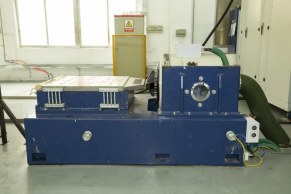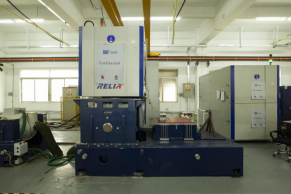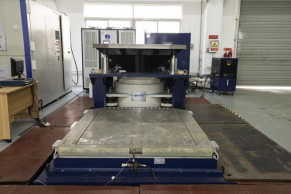1、 Basic information of the standard:
Standard name: Classification of environmental conditions Natural environmental conditions Impact and vibration data measured during storage, transportation, and use
Standard number: GB/T 4797.9-2021/IEC60721-2-9: 2014
This standard was issued on March 9, 2021 and implemented on October 1, 2021.
This standard is under the jurisdiction of TC8 (National Technical Committee for Standardization of Environmental Conditions and Environmental Testing of Electrical and Electronic Products) and is implemented by TC8/SC2 (Climate and Environmental Testing Branch of National Technical Committee for Standardization of Environmental Conditions and Environmental Testing of Electrical and Electronic Products). The competent department is the National Standardization Management Committee.
Introduction: This section of GB/T4797 aims to provide a strategy for developing environmental profiles based on data measured during product storage, transportation, and use in climate-protected or non climate-protected locations. The measured data is usually recorded in the form of an acceleration time history. Afterwards, select vibration and impact testing methods with appropriate severity from the IEC60068-2 series [1], apply the environmental levels given in IEC60721-3 [2], and update the environmental levels according to the strategies described in this section.
Scope and purpose of this standard:
The purpose of this section of GB/T4797 is to provide a strategy for developing environmental profiles based on data measured during the product lifecycle.
Its purpose is to define the basic parameters and quantities of impact and vibration, as the basis for determining the expected mechanical environmental severity of products during storage, transportation, and use throughout their lifespan.
Overview:
The impact and vibration signals measured on storage, transportation platforms, and usage sites vary from basic sinusoidal features to purely random features.
Random signals may have a normal or non normal distribution. If it is the latter, it is reasonable to assume that the process is the superposition of normally distributed random signals with different amplitudes mixed in a complex manner.
Real environments can rarely be simply classified as sinusoidal vibration environments, typically associated with discrete excitations such as rotating machinery, aircraft engines, and propellers
The excitation mechanism is associated and mixed with the related random vibration process. Product related specifications need to specify whether to conduct only random vibration tests or mixed mode tests.
The impact environment is closely related to the vibration environment at each stage of the product life cycle, and higher levels of acceleration are often generated in specific environments. If the packaged product is firmly fixed on the transportation platform base during transportation, the packaged product will not 'jump', and usually these impact signals contain frequencies within the bandwidth of 0Hz to 200Hz. Of course, higher frequencies may occur during use (perhaps in the kHz range), depending on the actual usage environment.
Introduction to some typical characteristics during the storage, transportation, and use stages:
1. Storage:
The product is stored for a long time and is not used during this period. The storage location may be a place with climate protection, partial climate protection, or no climate protection. During storage, the product will undergo handling, and the impact and vibration intensity it receives depends on the type of loading and unloading equipment and storage rack. The vibration and impact intensity caused by the influence of machines or passing vehicles during transportation vary from weak to strong. Especially when stored near heavy machinery and conveyor belts, the product may withstand stronger impacts and vibrations.
2. Transportation
2.1 Road transportation:
The product is always in an impact and vibration environment during road transportation. The main factors affecting the amplitude and frequency range of this environment are:
——- Structural design of transportation vehicles;
——- the driving speed of the vehicle;
——- Road conditions;
——- The position of the product in the vehicle;
——The relationship between the reference axis direction of vibration measurement and the axial direction of the vehicle is generally the most severe in the vertical direction;
——- The potential impact of the product on the vehicle's response characteristics;
——- Load distribution of the vehicle.
Early laboratories used sinusoidal vibration to simulate road transportation environments. Nowadays, random vibration simulation is commonly used, and the methods explained in this section are applicable to this technology. Due to significant differences in the conditions of road transportation and handling impacts, both are generally included in the test plan. If necessary, relevant specifications need to specify in detail whether there is such a requirement.
2.2. Rail transportation:
The track environment depends on the design of the train suspension system, and modern train suspension systems mainly rely on air suspension. Of course, not all trains are modern, especially freight trains, which experience high intensity and wide frequency vibration and impact environments. The environment of the air suspension system is very stable, usually in a low intensity low-frequency environment. The transition impact may generate significantly higher levels of acceleration, depending on the cushioning design. The main factors affecting the amplitude and frequency range of this environment are:
——- Type of train carriage suspension system;
——- Railway track conditions;
——- The position of the product in the train carriage;
——- Buffer type and impact speed during transition.
2.3 Air Transport
Air transportation can use jet, propeller, or rotor aircraft. There are significant environmental differences between different modes of transportation.
2.3.1 Jet Aircraft:
The environmental characteristics of jet aircraft are random, and the amplitude and frequency characteristics of impact and vibration vary depending on the position inside the cargo hold, with an upper frequency limit of up to 2000Hz.
2.3.2. Propeller type aircraft:
The environment of a propeller type aircraft is mainly composed of the sinusoidal components generated by the engine rotor, the propeller passage frequency and its harmonics, and the random background. These frequencies vary depending on the aircraft, but are usually concentrated within the frequency range of 200Hz. Based on this situation, random superposition of sine simulations is more suitable. However, as the distance from the rotating excitation source increases, the sinusoidal feature gradually weakens. In this case, random superposition random simulation is more suitable, or a simpler method can be used to simulate the situation at higher amplitudes using random modes with inter isolated dispersion frequency characteristics. The sinusoidal components between the propellers are usually very large, and if the product is sensitive to these frequencies, it should be avoided to place the product in this area.
2.4 Water transportation:
The aquatic environment is the superposition of the sinusoidal components generated by engines and propellers, as well as the random components generated by sea state excitation (ocean currents), the position of cargo on board the ship, and the position of cargo inside the cargo hold. The main factors affecting the amplitude and frequency range of this environment are:
——- the size of the vessel;
——- the speed of the vessel;
——- The position of the cargo hold on the ship;
——- The severity of loading, unloading and handling of goods at the port.
3. Usage:
The product undergoes significant environmental changes during its lifespan and is influenced by a series of factors, such as installation method, installation location, and distance from the vibration source. The use process is not limited to products installed indoors, but also covers all situations where the product is used in design and working mode.
The product may or may not be protected against climatic conditions during its lifespan, resulting in different combinations of factors. The main difference compared to other stages is that during the usage stage, the product usually needs to achieve functionality and complete tasks in a wider spectrum environment.
In other words, the impact of the environment during the use phase on the product is mostly the least significant, meaning it is usually possible to experience harsher environments during the transportation phase.
In order to clearly develop the test plan and determine the type of environment, it is necessary to have a deep understanding of the product's usage methods, in order to ensure that the product is used within its performance permitted range.
4. Vibration and shock data:
During on-site measurement, acceleration time history data can be measured using accelerometers and measuring instruments, which can be analog or digital and can be analyzed and processed multiple times.
Data is usually processed in one of the following forms, depending on the nature of the data:
——- Acceleration amplitude spectrum of sinusoidal data;
——- Impact response spectrum of impact data;
——- Acceleration spectral density (ASD) of random data.
The principles adopted in this section can be applied to the above forms of data processing.
2、 Standard drafting unit:

3、 Failure mechanism:
3.1 Vibration failure mechanism:
Vibration can cause product displacement, which can lead to structural fatigue, wear, deformation, collision, or fracture. Once the structure undergoes deformation, it can cause collision, friction, or fracture, which can lead to physical damage to the product and make it impossible to repair. These are usually caused by insufficient strength of the product. The strength of general products can meet the requirements, so most of the failures we see are caused by fatigue, and vibration is one of the main reasons for fatigue products.
The failures caused by vibration are as follows:
Structural damage: This type of damage includes deformation, bending cracks, fractures, and fatigue damage of the components that make up the product.
Working performance failure: This type of damage generally refers to the instability and deterioration of system performance caused by vibration, and some systems may even fail to function, such as electrical short circuits, wire wear, abnormal electrical contact, optical performance imbalance, etc.
Process performance damage: This type of damage generally refers to loose connections, seal failure, bearing wear, solder joint detachment, loose screws, poor contact of printed board pins, etc.
3.2 Mechanical impact failure mechanism:
When a product is impacted, its motion state will undergo sudden changes and generate transient responses. Its response is a high-frequency oscillation, short period, and high-energy wave with significant rise and fall. If the amplitude of the impact response exceeds the strength of the product, it will cause damage to the product.
General failure: Cracking or detachment of circuit board components, structural deformation or cracking of products, material damage at physical limits.
3.3 Mechanical collision failure mechanism:
When the product is subjected to continuous collisions, it can refer to the low cycle fatigue of the material. During each collision process, the packaging or product will deform, and once it accumulates to a certain level, it will cause qualitative changes, leading to packaging or product failure.
General failure: Cracking or detachment of circuit board components, structural deformation or cracking of products, and packaging damage.
4、 Youruite's vibration and impact testing capabilities

Electromagnetic shaker
| 1. Vibrate direction:Horizontal /Vertical 2. Max. sine force peak:2000kgf 3. Max. sine velocity peak:2m/s 4. Frequency range:DC~3000Hz 5. Max. acceleration sine peak:98g 6. Max. displacement (p-p):51mm 7. Horizontal platform size(mm):800×800 8. Vertical platform siz(mm):800×800 9. Controller system:Sine 、Random 、Shock 、RSTD 、4 Channels |

Electromagnetic shaker
| 1. Vibrate direction:Horizontal /Vertical 2. Max. sine force peak:5500kgf 3. Max. sine velocity peak:2m/s 4. Frequency range:DC~2500Hz 5. Max. acceleration sine peak:98g 6. Max. displacement (p-p):80mm 7. Horizontal platform size(mm):1400×1400/700×700 8. Vertical platform siz(mm):1400×1400/700×700 9. Controller system:Sine 、Random 、Shock 、RSTD、 8 Channels |

Electromagnetic shaker
| 1. Vibrate direction:Horizontal /Vertical 2. Max. sine force peak:18000kgf 3. Max. sine velocity peak:2m/s 4. Frequency range:DC~2200Hz 5. Max. acceleration sine peak:98g 6. Max. displacement (p-p):51mm 7. Horizontal platform size(mm):1800×1800 8. Vertical platform siz(mm):1800×1800 9. Control System: Sine, Random, Shock, Sine + Random, Random + Random, RSTD, 16 Channels |

Mechanical Shocker
| 1. Waveform:Half sine 2. Max. payload:50kg 3. Acceleration:150~6500m/s2 4. Pulse duration:1ms~30ms 5. Max. shock height:1500mm |

Mechanical Shocker
| 1. Waveform:Half sine 2. Max. payload:10kg 3. Acceleration:150~2m/s2 4. Pulse duration:0.5ms~20ms 5. Max. shock height:1500mm |

Bump testing | Impact parameters: 1. Waveform:Half sine 2. Max. payload:50kg 3. Acceleration:100~15000m/s2 4. Pulse duration:0.8ms~40ms 5. Maximum impact speed variation:8.2m/s 6. Table size(mm): 400×400 impact parameter: 1. Waveform:Half sine 2. Max. payload:50kg 3. Acceleration:30~2000m/s2 4. Pulse duration:1.5ms~30ms 5. Maximum impact speed variation:3.8m/s 6. Table size(mm): 400×400 |
5、ORT participated in drafting and published standards:
1. GB/T 35774-2017 'Specification for Performance Testing of Transport Packaging Components'
2. GB/T 4857.1-2019 'Basic Testing of Packaging, Transportation, and Packaging Components - Part 1: Marking Methods for Various Parts during Testing'
3. GB/T 4798.1-2019 'Classification of Environmental Conditions - Classification of Environmental Parameter Groups and Classification of Their Severity - Part 1: Storage'
4. GB/T 2421-2020 'Overview and Guidelines for Environmental Testing'
5. GB/T 2423.27-2020 'Environmental Testing - Part 2: Test Methods, Test Methods and Guidelines: Temperature/Low Pressure or Temperature/Humidity/Low Pressure Combined Tests'
6. GB/T 2423.51-2020 'Environmental Testing - Part 2: Test Methods - Test Ke: Flow Mixed Gas Corrosion Test'
7. GB/T 32065.8-2020 Marine Instruments - Environmental Testing Methods - Part 8: Temperature Change Test
8. GB/T 32065.10-2020 Marine Instruments - Environmental Testing Methods - Part 10: Salt Spray Test
9. GB/T 4797.9-2021 Classification of Environmental Conditions - Natural Environmental Conditions - Shock and Vibration Data Measured during Storage, Transportation, and Use
10. GB/T 2423.33-2021 Environmental Testing Part 2: Test Methods Test Kca: High Concentration Sulfur Dioxide Test
11. GB/T 2423.18-2021 Environmental Testing Part 2: Test Methods Test Kb: Salt Spray, Alternating (Sodium Chloride Solution)
12. NB/T 10279-2019 'Wet and Hot Environmental Conditions for Transmission and Transformation Equipment'
13. NB/T 10280-2019 'Wet and Hot Environmental Conditions and Technical Requirements for State Monitoring Devices Used in Power Grids'
14. YZ/T 0174-2020 Technical Requirements for Cold Chain Delivery Insulation Box
15. T/CPF 0012-2020 Guidelines for Testing Small Transport Packages for Express Delivery
16. T/CPF 0011-2020 Guidelines for Testing Electrical Transportation Packaging in E-commerce Logistics